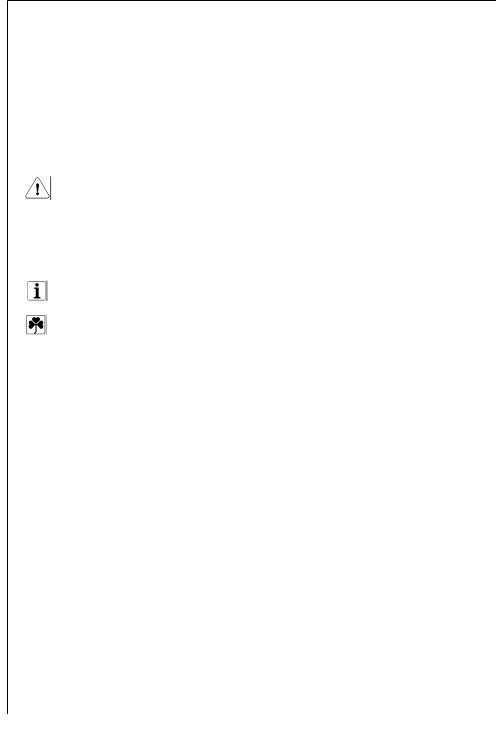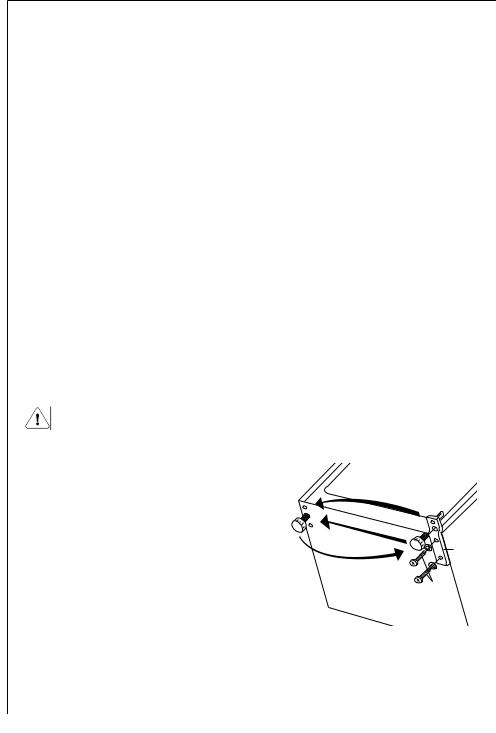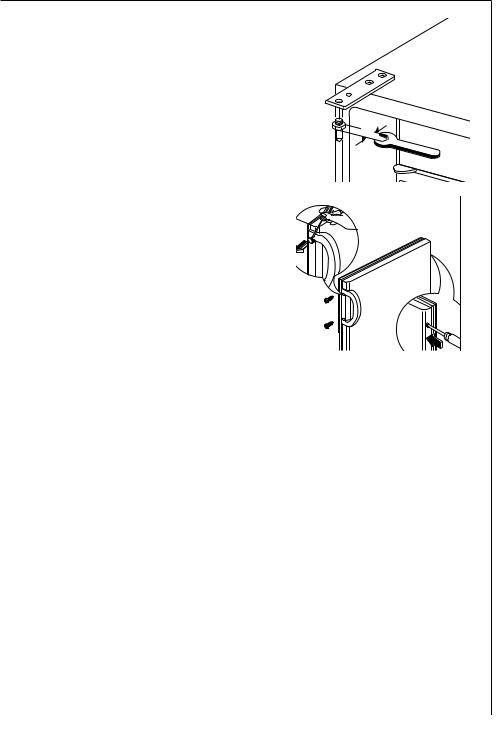AEG-Electrolux A1283GS7 User Manual

ARCTIS
Tisch-Gefrierautomat electronic
Congélateur automatique table top électronique
Electronic Table Top Freezer
Gebrauchsanweisung
Mode d’emploi
Operating Instructions

Dear customer,
Before placing your new refrigerator/freezer into operation please read these operating instructions carefully. They contain important information for safe use, for installation and for care of the appliance.
Please keep these operating instructions for future reference. Pass them on to possible new owners of the appliance.
These operating instructions are for use with several technically comparable models with varying accessories. Please observe the notes which apply to your model.
Notes which are important for your safety or for the proper functioning of the appliance are stressed with a warning triangle and/ or with signal words (Warning!, Caution!, Attention!). Please observe the following carefully.
This symbol guides you step by step in the operation of the appliance.
Supplementary information regarding operation and practical applications of the appliance appear after this symbol.
Tips and notes concerning economical and environmentally sound use of the appliance are marked with the cloverleaf.
The operating instructions contain instructions for the correction of possible malfunctions by the user in the section "What to do if ...". If these instructions should not be sufficient, our customer service department is always available to you.
Printed on paper manufactured with environmentally sound processes.
he who thinks ecologically acts accordingly ...
50

Contents
Safety . . . . . . . . . . . . . . . . . . . . . . . . . . . . . . . . . . . . . . . . . . . . . . . . . . . 52 Disposal . . . . . . . . . . . . . . . . . . . . . . . . . . . . . . . . . . . . . . . . . . . . . . . . . . 54
Appliance Packaging Information . . . . . . . . . . . . . . . . . . . . . . . . . . . . . . . . 54 Disposal of old Appliances. . . . . . . . . . . . . . . . . . . . . . . . . . . . . . . . . . . . . . 54
Remove transport safeguard . . . . . . . . . . . . . . . . . . . . . . . . . . . . . . . . . . 54 Installation . . . . . . . . . . . . . . . . . . . . . . . . . . . . . . . . . . . . . . . . . . . . . . . 55
Installation Location . . . . . . . . . . . . . . . . . . . . . . . . . . . . . . . . . . . . . . . . . . 55 Your freezer needs air . . . . . . . . . . . . . . . . . . . . . . . . . . . . . . . . . . . . . . . . . 55 Electrical connection . . . . . . . . . . . . . . . . . . . . . . . . . . . . . . . . . . . . . . . . . . 56 Reversing the door. . . . . . . . . . . . . . . . . . . . . . . . . . . . . . . . . . . . . . . . . . . . 56
Prior to initial start-up . . . . . . . . . . . . . . . . . . . . . . . . . . . . . . . . . . . . . |
57 |
Description of the appliance . . . . . . . . . . . . . . . . . . . . . . . . . . . . . . . . . . |
58 |
Control panel . . . . . . . . . . . . . . . . . . . . . . . . . . . . . . . . . . . . . . . . . . . . . |
58 |
Buttons for adjusting the temperature . . . . . . . . . . . . . . . . . . . . . . . . . . . . |
59 |
Temperature display . . . . . . . . . . . . . . . . . . . . . . . . . . . . . . . . . . . . . . . . . . . |
59 |
FROSTMATIC button. . . . . . . . . . . . . . . . . . . . . . . . . . . . . . . . . . . . . . . . . . . |
60 |
Initial Start-Up . . . . . . . . . . . . . . . . . . . . . . . . . . . . . . . . . . . . . . . . . . . . 60
Ice pack . . . . . . . . . . . . . . . . . . . . . . . . . . . . . . . . . . . . . . . . . . . . . . . . . . . . 60
Temperature Adjustment . . . . . . . . . . . . . . . . . . . . . . . . . . . . . . . . . . . . . 61 Switching the appliance off . . . . . . . . . . . . . . . . . . . . . . . . . . . . . . . . . . 61 Control and Information System . . . . . . . . . . . . . . . . . . . . . . . . . . . . . . . 62
Temperature warning. . . . . . . . . . . . . . . . . . . . . . . . . . . . . . . . . . . . . . . . . . 62 Malfunctions . . . . . . . . . . . . . . . . . . . . . . . . . . . . . . . . . . . . . . . . . . . . . . . . 62
Freezing and storing frozen food . . . . . . . . . . . . . . . . . . . . . . . . . . . . . . 63 Storage Goods Symbols/Freezing Calendar . . . . . . . . . . . . . . . . . . . . . . . 64 Preparation of Ice Cubes . . . . . . . . . . . . . . . . . . . . . . . . . . . . . . . . . . . . . 65 Defrosting . . . . . . . . . . . . . . . . . . . . . . . . . . . . . . . . . . . . . . . . . . . . . . . . 65 Cleaning and Care. . . . . . . . . . . . . . . . . . . . . . . . . . . . . . . . . . . . . . . . . . 66 Magnetic door seal . . . . . . . . . . . . . . . . . . . . . . . . . . . . . . . . . . . . . . . . . 67 If you should ever move house . . . . . . . . . . . . . . . . . . . . . . . . . . . . . . . . 67 Energy Saving Tips . . . . . . . . . . . . . . . . . . . . . . . . . . . . . . . . . . . . . . . . . 68 What to do if... . . . . . . . . . . . . . . . . . . . . . . . . . . . . . . . . . . . . . . . . . . . . 68
Correcting Malfunctions . . . . . . . . . . . . . . . . . . . . . . . . . . . . . . . . . . . . . . . 68
Customer Service. . . . . . . . . . . . . . . . . . . . . . . . . . . . . . . . . . . . . . . . . . . 71 Noises during Operation . . . . . . . . . . . . . . . . . . . . . . . . . . . . . . . . . . . . . 71 Regulations, Standards, Guidelines . . . . . . . . . . . . . . . . . . . . . . . . . . . . . 72 Thechnical terminology . . . . . . . . . . . . . . . . . . . . . . . . . . . . . . . . . . . . . . 73
51

 Important Safety Instructions
Important Safety Instructions
These warnings are provided in the interests of your safety. Ensure you fully understand them before installing or using the appliance. Your safety is of paramount importance. If you are unsure about the meaning of these warnings contact the Customer Care Department for assistance.
Intended use
•The freezer is intended for use in the home. It is suitable for the freezing and storing frozen food, as well as for making ice. If the appliance is used for purposes other than those intended or used incorrectly, no liability can be accepted by the manufacturer for any damage that may be caused.
•Alterations or changes to the freezer are not permitted for reasons of safety.
•If you use the freezer in a commercial application or for purposes other than the freezing or frozen storage of foods, the manufacturer accepts no liability for any damages which may occur.
Prior to initial start–up
•Ensure that the appliance does not stand on the electrical supply cable. Important: if the supply cable is damaged, it must be replaced by authorised service or qualified personnel using a special cable of the same type.
•Check the appliance for transport damage. Under no circumstance should a damaged appliance be plugged in. In the event of damage, please contact your supplier.
Refrigerant
The refrigerant isobutane (R600a) is contained within the refrigerant circuit of the appliance, a natural gas with a high level of environmental compatibility, which is nevertheless flammable.
•During transportation and installation of the appliance, be certain that none of the components of the refrigerant circuit become damaged.
•If the refrigerant circuit should become damaged:
–avoid open flames and sources of ignition;
–thoroughly ventilate the room in which the appliance is situated.
Safety of children
•Packaging (e.g. wraps, polystyrene) can be dangerous for children. There is a risk of suffocation! Keep packaging material away from children!
•Please make old appliances unusable prior to disposal. Pull out the
52

mains plug, cut off the mains cable, break or remove spring or bolt catches, if fitted. By doing this you ensure that children cannot lock themselves in the appliance when playing (there is risk of suffocation!) or get themselves into other dangerous situations.
•Often children cannot recognise the hazards present in household appliances. It is therefore important that you ensure adequate supervision and never let children play with the appliance!
Daily Operation
•Containers with flammable gases or liquids can leak at low temperatures. There is a risk of an explosion! Do not store any containers with flammable materials such as spray cans, fire extinguisher refill cartridges etc in the appliance.
•Bottles and cans must not be placed in the freezer. They can burst when the contents freeze, high carbonate content drinks can even explode! Never store lemonade, juices, beer, wine, sparkling wine etc. in the freezer. Exception: high alcohol content spirits can be stored in the freezer.
•Do not put ice creams or ice cubes in the mouth immediately after removal from the freezer. Very cold ice can freeze to the lips or tongue and cause injury.
•Do not touch frozen food with wet hands. Your hands could freeze to the food.
•Do not operate any electrical appliances in the freezer (e.g. electric ice cream makers, mixers etc.).
•Placing frozen goods on the top of the appliance can lead to the accumulation of condensation in the cavity of the storag etray through contact with the cold. Electronic components are housed within this cavity. If condensation should drip onto these components, the appliance could be damaged by a short circuit. For this reason do not place frozen goods on top of the appliance.
•Before cleaning the appliance, always switch off the appliance and unplug it, or pull the house fuse or switch off the circuit breaker.
•When unplugging always pull the plug from the mains socket, do not pull on the cable.
In case of malfunction
•If a malfunction occurs on the appliance, please look first in the "What to do if ..." section of these instructions. If the information given there does not help, please do not perform any further repairs yourself.
•Under no circumstance should you attempt to repair the appliance yourself. Repairs carried out by inexperienced persons may cause injury or serious malfunctioning. Contact our Customer Service.
53

Disposal
Appliance Packaging Information
All materials are environmentally sound! They can be disposed of or burned at an incinerating plant without danger.
About the materials: The plastics can be recycled and are identified as follows:
>PE< for polyethylene, e.g. the outer covering and the bags in the interior.
>PS< for polystyrene foam, e.g. the pads, which are all free of chlorofluorocarbon.
The carton parts are made from recycled paper and should be disposed of at a waste-paper recycling collection location.
Disposal of old Appliances
For environmental reasons, refrigeration appliances must be disposed of properly. This applies to your old appliance, and - at the end of its service life - for your new appliance as well.
Warning! Before disposing of old appliances make them inoperable. Remove plug from mains, sever the power cable, remove or destroy any snap or latch closures. This ensures that playing children do not lock themselves inside the appliance (danger of suffocation!) or place themselves into other life-endangering situations.
Disposal:
•The appliance may not be disposed of with domestic waste or bulky refuse.
•The refrigerant circuit, especially the heat exchanger at the back of the appliance, must not be damaged.
•Information concerning collection schedules or locations can be obtained from your local Council or Environmental Health Office.
Remove transport packaging
The appliance and the interior fittings are protected for transport.Pull off the adhesive tape on the left and right side of the door.
You can remove any remnants of adhesive using white spirit.
Remove all adhesive tape and packing pieces from the interior of the appliance.
54

Installation
Installation Location
The appliance should be set up in a well ventilated, dry room.
Energy use and efficient performance of the appliance is affected by the ambient temperature.
The appliance should therefore
–not be exposed to direct sunlight;
–not be installed next to radiators, cookers or other sources of heat;
–only be installed at a location whose ambient temperature corresponds to the climate classification, for which the appliance is designed.
The climate classification can be found on the serial plate, which is located at the left on the inside of the appliance.
The following table shows which ambient temperature is correct for each climate classification:
Climate classification |
|
for an ambient temperature of |
|
|
|
|
|
|
SN |
|
+10 to +32 °C |
|
|
|
|
|
|
N |
|
+16 to +32 °C |
|
|
|
|
|
|
ST |
|
+18 to +38 °C |
|
|
|
|
|
|
T |
|
+18 to +43 °C |
|
|
|
If installation next to a source of heat is unavoidable, the following minimum clearances must be maintained at the sides of the appliance:
–for electric cookers 3 cm;
–for oil and coal fired ranges 30 cm.
If these clearances cannot be maintained a heat insulating pad is required between the cooker and the refrigeration appliance.
If the refrigeration appliance is installed next to another refrigerator or freezer a clearance of 5 cm at the sides is required, in order to prevent the formation of condensation on the outside of the appliance.
Your appliance needs air
Your freezer is designed for maintenance-free operation. What it should never lack is good ventilation. Air is supplied under the ventilation slot between the freezer and storage surface. Air is extracted through the upper ventilation grille. Never obstruct these openings.
55

Electrical Connection
The plug socket necessary for connection of your appliance to the electricity supply should be positioned so that it is possible to pull out the appliance plug.
A concealed protective contact plug socket requires 10 A/16 A fusing. If the socket is not accessible, the electrical installation must include suitable means of isolating the appliance from the mains (e.g. fuse, cut-out, current trip or similar with a minimum contact separation of
3 mm).
Before initial start-up, refer to the appliance serial plate to ascertain if supply voltage and current values correspond with those of the mains at the installation location.
e.g.: AC 220 ... 240 V |
50 Hz or |
220 ... 240 V |
~50 Hz |
(i.e. 220 to 240 volts alternating current, 50 Hertz) The rating plate is inside the appliance on the left.
Reversing the door
The side at which the door opens can be changed from the right side (as supplied) to the left side, if the installation site requires.
Warning! When changing the side at which the door opens, the appliance must not be connected to the mains. Remove plug from the mains beforehand.
Tilt the appliance slightly towards the rear and prop it securely.
Unscrew the door hinge screws (K) and remove the hinge pin bracket (1).
Open the door a little way and take it |
1 |
out downwards.
K
AEG97
56

Unscrew the upper pin (A) and screw it into place on the opposite side.
Fit the door into the upper pin (A) and close it.
Screw the hinge pin bracket (1) securely into place on the opposite side using the screws (K).
A |
12 |
|
AEG98
Unscrew the handle. Refit it on the opposite side after having pushed in the plugs with a punch. Cover the holes left open with the plugs contained in the documentation pack.
Prior to Initial Start–Up
Please clean the appliance interior and all accessories prior to initial start-up (see section: “Cleaning and Care”).
Remove the ice pack from the appliance.
Only put the ice pack to freeze in the top drawer after the optimal storage temperature of –18 °C has been reached.
Re-freeze thawed ice packs in the same way, e. g. after cleaning the appliance.
57
